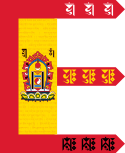More languages
More actions
| Bogd Khanate of Mongolia ᠪᠣᠭᠳᠠ ᠬᠠᠭᠠᠨᠲᠤ ᠮᠣᠩᠭᠣᠯ ᠤᠯᠤᠰ Богд хаант Монгол Улс | |
|---|---|
| 1911–1924 | |
| Capital | Niislel Khüree |
| Common languages | Mongolian |
| Dominant mode of production | Feudalism |
| Government | Theocratic monarchy |
• Khan | Bogd Khan |
The Bogd Khanate of Mongolia was a theocratic feudal state that existed between the 1911 national liberation revolution and the 1921 socialist revolution in Mongolia.
Background
Following the 1904–5 Russo-Japanese War, Inner Mongolia fell under Japan's sphere of influence while Outer Mongolia fell under Russia's influence. The Russian Empire sought to control Mongolia in order to gain an advantage against imperialist Japan. Between 1891 and 1908, Russian exports to Mongolia increased by 22% while Mongolian exports to Russia increased by 566%.
In early 1911, Colonel Tan from the declining Qing dynasty arrived in Mongolia and ordered barracks to be built in Örgöö (now Ulaanbaatar). The Mongol nobility held a secret meeting in July planning to break away from the Qing and notified the Russian ambassador to Mongolia. In October, the collapsing Qing agreed not to do any reforms in Outer Mongolia without Russian approval.[1]:232–7
1911 revolution
Mongolia declared independence on 1911 December 1, and the Chinese garrison returned to China under the protection of Russian Cossacks. The Qing official in Khovd sealed himself inside a fort with many soldiers and supplies and requested reinforcements from Xinjiang, which Russia prevented from arriving. On 1912 August 6, the peasants stormed the fortress and destroyed debt records. After the Qing was overthrown, the feudal nobility led by the Bogd Khan took power.[1]:237–8
References
- ↑ 1.0 1.1 A. A. Guber, et al. (1973). History of the Mongolian People's Republic: 'The Overthrow of Manchu Rule and the Formation of a Feudal-Theocratic Mongolian State'.


